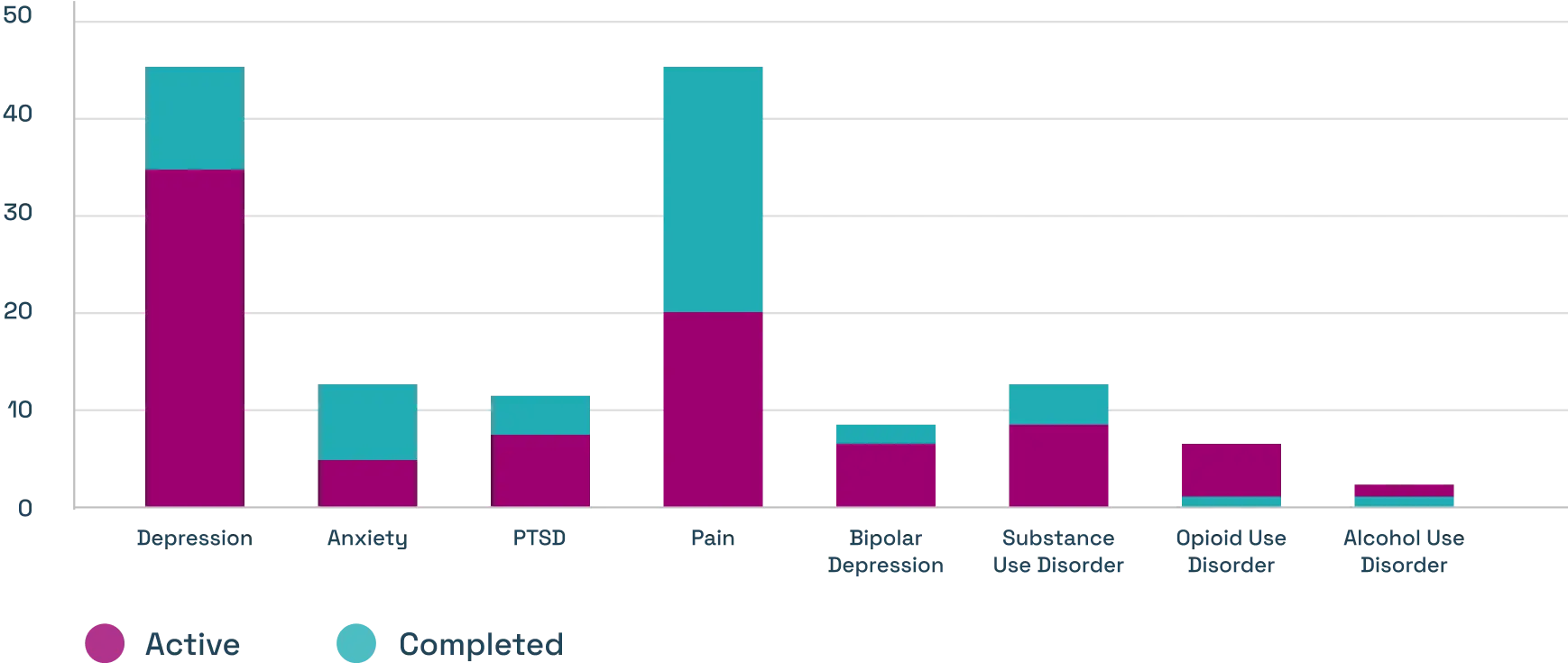What is Ketamine?Originally developed as a powerful anesthetic and painkiller, ketamine was used effectively in hospitals and on the battlefields of Vietnam for decades. In 2019, esketamine, a derivative of ketamine, gained FDA approval for people with treatment-resistant depression, major depressive disorder, and suicidality. Recent studies show promising results for other mental health disorders, including post-traumatic stress disorder (PTSD), obsessive-compulsive disorder) OCD, and substance abuse (clinically known as substance use disorder).
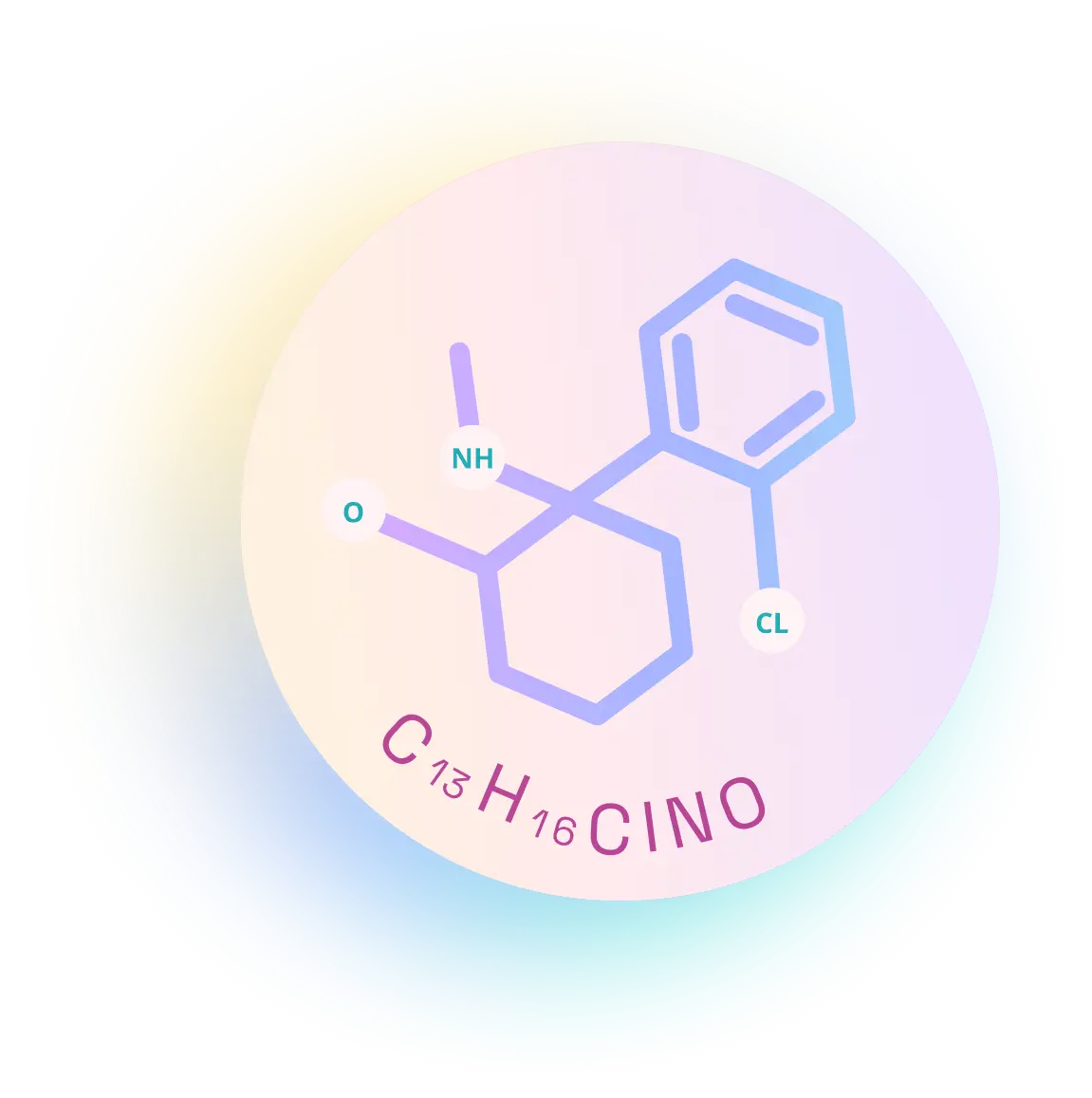
Ketamine History and Origins
What Are the Effects of Ketamine?Ketamine acts as an NMDA
(N-methyl-D-aspartate) antagonist. This means that ketamine binds to and alters the function of the NMDA receptor, a part of the brain’s glutamate system.
Glutamate is a vital neurotransmitter (chemical messenger) that is thought to be partially responsible for regulating mood and certain mental health disorders like depression and anxiety.(1)
Ketamine effectively changes how the NMDA receptor interacts with glutamate. This alteration may be responsible for ketamine’s potential ability to treat certain mental health conditions.(1)
Glutamate plays a large role in how pain is perceived. The mechanism of ketamine’s ability to impact chronic pain symptoms is due to its antagonism of the NMDA receptor, which contributes to its pain-relieving actions on the brain and spinal cord. The NMDAR is partially responsible for how we perceive pain signals, which contributes to why some research suggests that ketamine profoundly affects opioid tolerance reversal.(2,3)
Ketamine effectively changes how the NMDA receptor interacts with glutamate. This alteration may be responsible for ketamine’s potential ability to treat certain mental health conditions.(1)
Glutamate plays a large role in how pain is perceived. The mechanism of ketamine’s ability to impact chronic pain symptoms is due to its antagonism of the NMDA receptor, which contributes to its pain-relieving actions on the brain and spinal cord. The NMDAR is partially responsible for how we perceive pain signals, which contributes to why some research suggests that ketamine profoundly affects opioid tolerance reversal.(2,3)
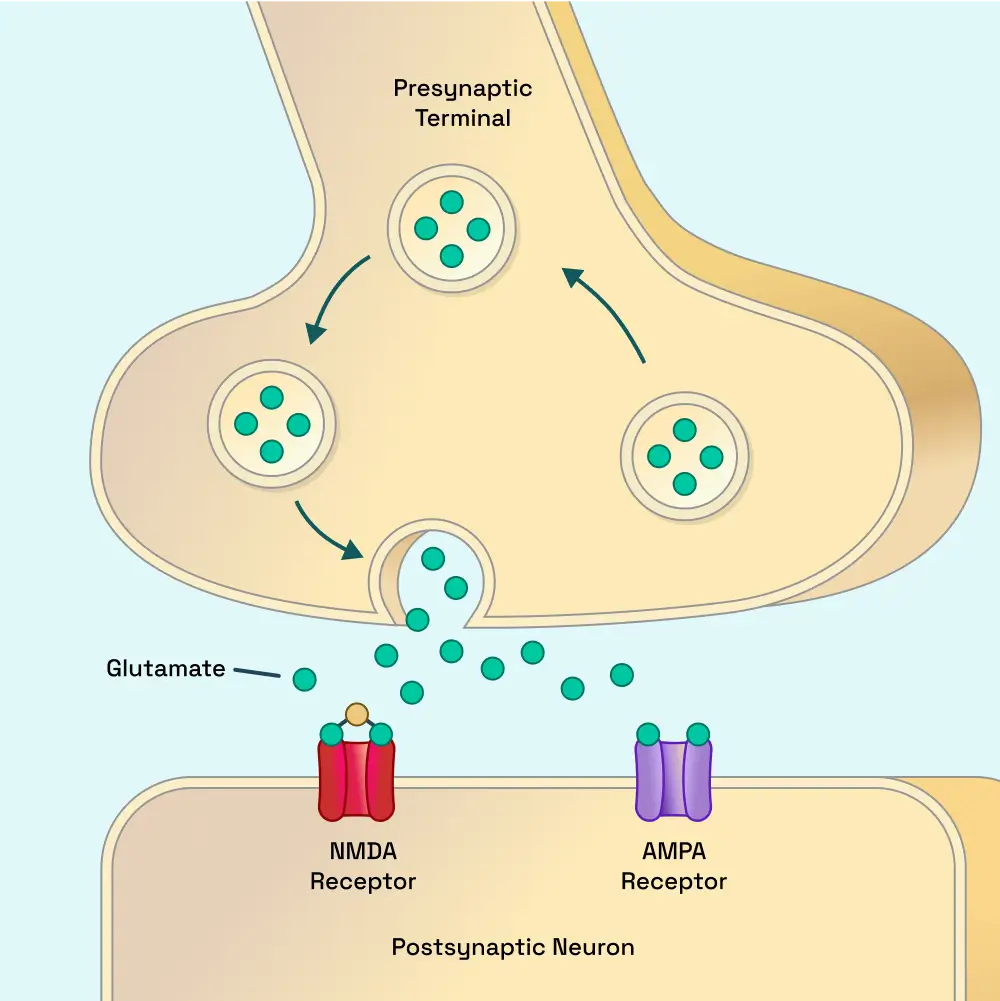
What Does Ketamine Feel Like?
Depending on the dosage, ketamine can make you feel a wide range of sensations and experience perceptual changes.
In low doses, ketamine may make you happy, euphoric, light-headed, or relaxed. You may also feel a sense of timelessness, see color changes (like increased vibrancy), or hear more intense, nuanced sounds. Many patients report feeling like they are floating and detached from themselves. This is known as dissociation or the sensation of being separate from yourself.(4)
Typical responses to ketamine:
Ketamine may also reduce feelings of fear and pain.(5) However, all of these altered states are only temporary. Patients usually feel completely normal within a few hours of finishing a ketamine therapy session.
Glossary of Ketamine Terms
Ketamine therapy is a relatively new and complex treatment modality. As such, some of the terms can be confusing, especially if you aren’t familiar with ketamine. Our glossary of terms can help you better understand the technical aspects of ketamine treatment.
Agonist
Activates a receptor in the brain, thus producing a response.
ANTAgonist
A drug or chemical that blocks a receptor rendering it ineffective.
Anesthetic
Something that reduces sensation, either locally or in general.
Dissociation
A feeling of detachment from one’s self and body. Likened to viewing yourself from the outside or third-person perspective.
Glutamate
One of the most abundant and important neurotransmitters in the brain. Thought to play an important role in mood regulation.
Integrative Counseling
Counseling designed to address immediate, specific concerns before, during, or after ketamine treatment. These can be held with either a licensed or unlicensed guide, therapist, or counselor.
Ketamine-Assisted Psychotherapy (KAP)
Psychotherapy sessions from a licensed therapist that occur in conjunction with Ketamine treatment.
K-Hole
An event that can occur after ingesting a high dose of ketamine. It can cause marked, sometimes unpleasant, confusion and mind/body dissociation. It may also be difficult to move or communicate. Fortunately, this is only temporary.
Neurotransmitter
A chemical signal molecule released by the brain and central nervous system that allows the brain cells to communicate with one another.
NMDA Receptor
N-methyl-D-aspartate receptor, one of the receptors that glutamate binds with.
Off-Label
A medication used for purposes outside its specific FDA approval.
Serotonin
A critical neurotransmitter involved with mood regulation, learning, memory, cognition, and many other physiological processes.
SSRI
Also known as a selective serotonin inhibitor. This is a class of drug typically prescribed as an antidepressant.
How is Ketamine Taken or Administered?
1
Intravenous (IV)
2
Intramuscular (IM)
3
Sublingual
or Oral Lozenge
or Oral Lozenge
4
Nasal Spray
How Does the Way You Take Ketamine, and Your Dosage, Change the Experience?Different methods of administering ketamine can change its effects, onset, and duration. For example, when given in an IV drip, ketamine can be felt within as little as a few minutes and may last several hours. Whereas the nasal spray and lozenge methods have a longer onset delay and generally less-pronounced effects.(6)
Ketamine Onset of Action
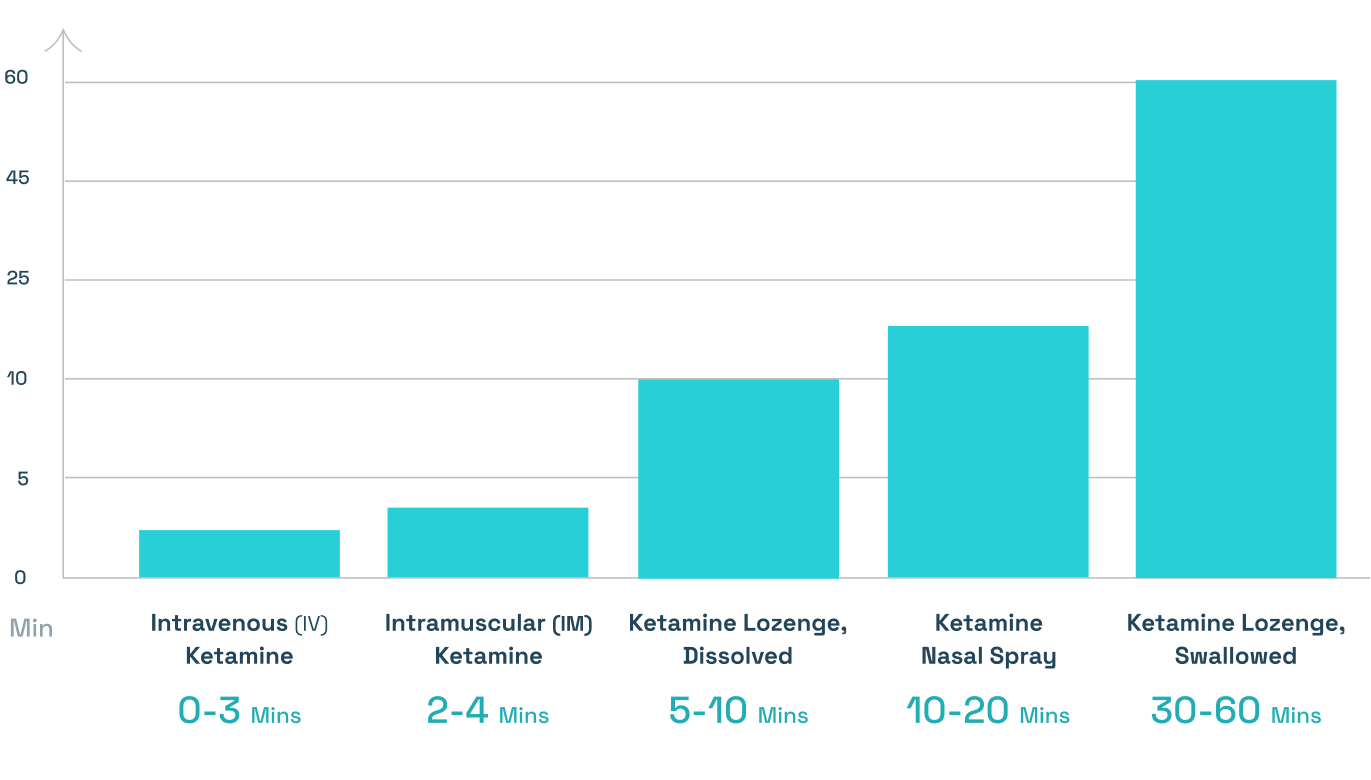
Getting the Most Out of Your Ketamine ExperienceThere is a possibility that when paired with integrative counseling and psychotherapy, the effects of ketamine therapy may be more pronounced and long-lasting.
When you combine ketamine, an already powerful treatment, with psychotherapy techniques, you can address issues that ketamine brings to the surface faster and more successfully.(7)

Ketamine vs. Traditional Antidepressants for Treatment-Resistant Conditions
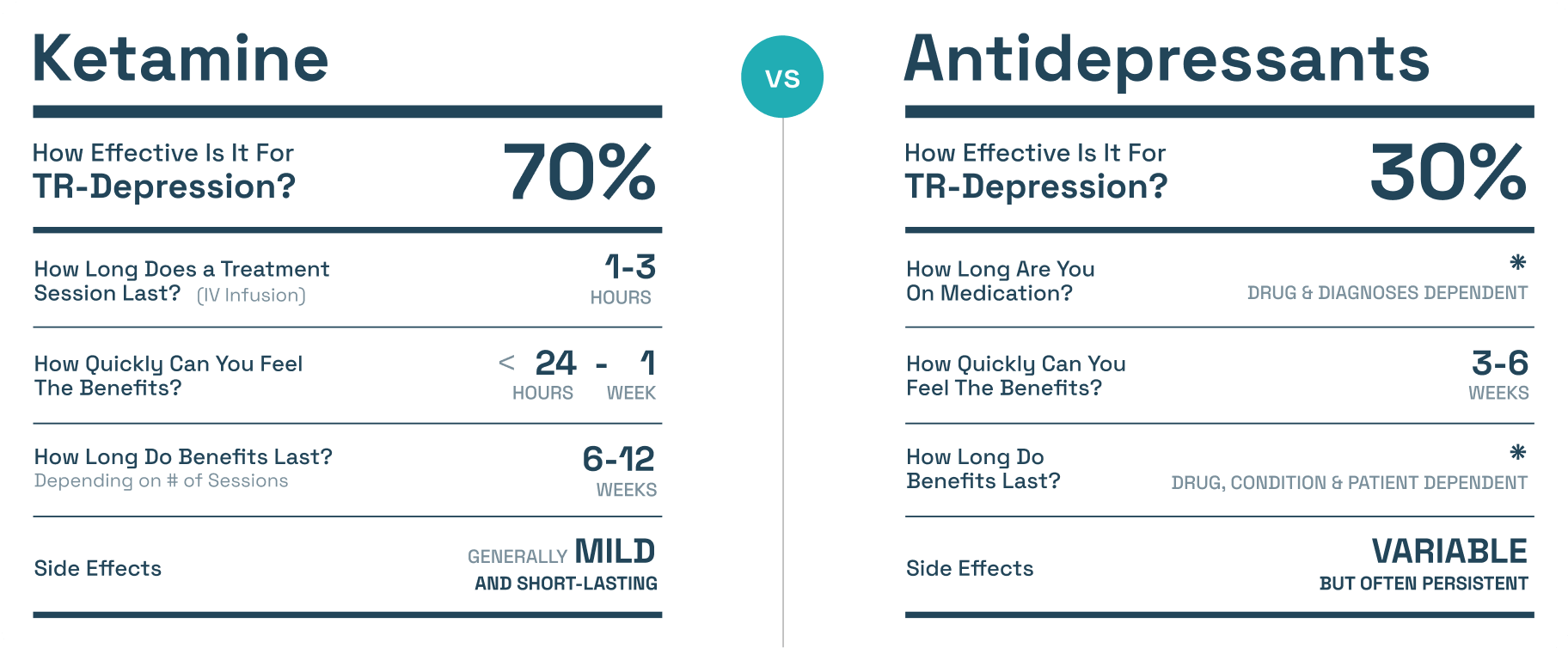
What is Ketamine-Assisted Psychotherapy and Integrative Counseling?
Ketamine-assisted psychotherapy (KAP) is an intervention that pairs ketamine with psychiatric care from a licensed mental health professional to address cognitive and emotional suffering. This provider is there to help you learn from and integrate lessons from your ketamine session.(8)
Ketamine can also be combined with integrative counseling (therapy that uses techniques from various schools of thought), and could include alternative care like herbal medicine, nutrition, yoga, and meditation. This form of counseling aims to address observations or concerns that occur during the ketamine experience.(9)
Ketamine can be an effective therapy tool because it may reduce the fight or flight response while encouraging neurogenesis (repair and growth of new neural connections). By reducing how acute your fear response is, ketamine can help you address painful or traumatic topics that you may subconsciously avoid.(10,11)
At the same time, the new neural pathways allow you to think in novel and interesting ways. This neuroplasticity (mental flexibility) may help you break free of harmful and reductive thought patterns, allowing you to heal faster and more fully.
Ketamine can also be combined with integrative counseling (therapy that uses techniques from various schools of thought), and could include alternative care like herbal medicine, nutrition, yoga, and meditation. This form of counseling aims to address observations or concerns that occur during the ketamine experience.(9)
Ketamine can be an effective therapy tool because it may reduce the fight or flight response while encouraging neurogenesis (repair and growth of new neural connections). By reducing how acute your fear response is, ketamine can help you address painful or traumatic topics that you may subconsciously avoid.(10,11)
At the same time, the new neural pathways allow you to think in novel and interesting ways. This neuroplasticity (mental flexibility) may help you break free of harmful and reductive thought patterns, allowing you to heal faster and more fully.
Reduction in Depression and Anxiety Symptoms Post-Ketamine Treatment vs. Pre-Ketamine TreatmentKetamine-Assisted Psychotherapy (KAP) Significantly Decreases in Depression and Anxiety Symptoms Post-Ketamine Treatment vs. Before Ketamine Treatment.
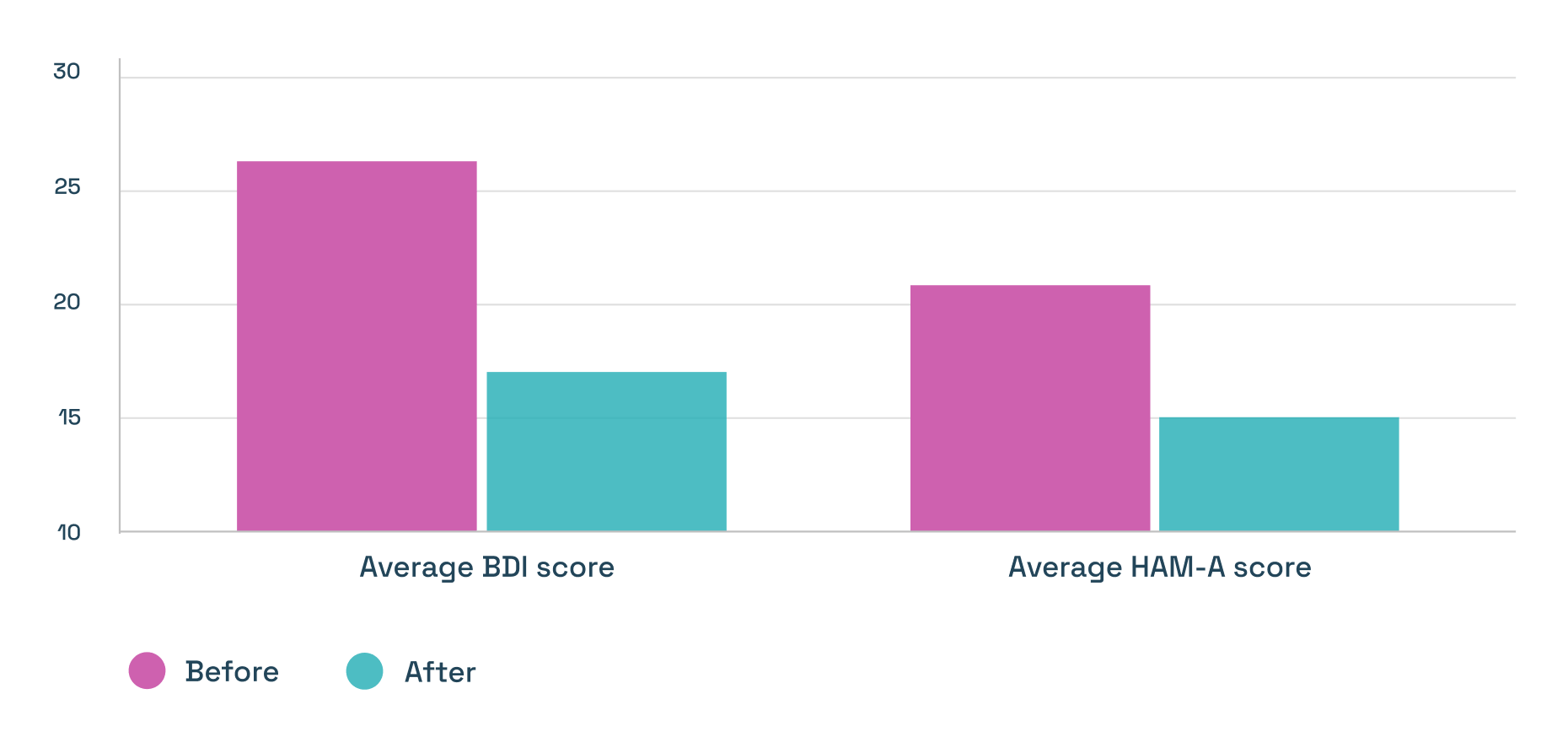
Patient Demographics, Clinical Data, and Outcomes in Three Large Practices Administering Ketamine with Psychotherapy. Jennifer Dore, Brent Turnipseed, Shannon Dwyer, Andrea Turnipseed, Julane Andries, German Ascani, Celeste Monnette, Angela Huidekoper, Nicole Strauss & Phil Wolfson. More

What to Look for When Selecting a Ketamine Therapy Provider
Ketamine-Assisted Therapy is a complex medical intervention that requires expertise. When searching for a ketamine provider, do comparisons between prices and services offered, and look for positive reviews, qualifications, and experience.
At-Home vs. In-Office
At-Home
vs
In-Office
What Does the Science Say?
Ketamine for AnxietyLiving with anxiety doesn’t have to slow you down. Studies have shown that ketamine can be effective for up to 89% of patients with anxiety disorder.(12)
Ketamine for DepressionDepression is a leading cause of disability in the U.S. and around the globe. Ketamine could help up to 70% of people with treatment-resistant depression live fuller, happier lives.(13)
Ketamine for OCDObsessive-compulsive disorder can greatly impact one’s quality of life. Studies indicate ketamine for OCD could help up to 50% of OCD patients improve their symptoms.(14)
Ketamine for PTSDAnyone who has experienced trauma can develop post-traumatic stress disorder. For those that do, it can be debilitating. Ketamine could help up to 80% of people with PTSD.(15)
Ketamine for Substance AbuseAddiction is a complex condition with many underlying factors, making it difficult to treat. Early trials indicate that ketamine for substance abuse (also known as substance use disorder) could help up to 50% of people beat addiction and reclaim their lives.(16)
Ketamine for Pain Management Ketamine has been used as an anesthetic since the 1970s, marking over five decades of practical application in the medical field. Ketamine may also reduce post-operative opiate usage in some patients, and some studies indicate it has a promising role in pain management.
Ketamine Safety and Risks
Ketamine is a relatively safe and well-tolerated medication. Ketamine has few long-term side effects and does not suppress the respiratory system.
However, ketamine does carry some risks. Ketamine can cause an altered perception of sounds and colors, changes in thinking patterns, confusion, upset stomach, and a loss of coordination or bodily control. Typically, these side effects have a short duration, lasting around the same amount of time as the ketamine session (one to three hours), with most patients feeling back to normal within a few hours of ketamine treatment.
Ketamine may not be suitable for everyone. You should consult a medical provider before beginning ketamine treatment to ensure it’s safe for you and your unique health concerns.
Ketamine may not be suitable for everyone. You should consult a medical provider before beginning ketamine treatment to ensure it’s safe for you and your unique health concerns.

Ketamine Costs & Insurance Coverage
Insurance coverage for some ketamine treatments may be limited. Currently, only esketamine, marketed as Spravato, is FDA-approved and may be covered by insurance.
You should contact your insurance provider to learn if your specific plan covers ketamine treatments. While many insurance providers may not cover the cost ketamine, they may cover pre-treatment consultations, office visits, or psychotherapy.
Additionally, you should expect to pay more for your ketamine treatment depending on what other services are offered or paired with it. For example, ketamine-assisted psychotherapy (KAP) will cost more on average than ketamine infusions alone or ketamine combined with integrative therapy.
While studies on the increased efficacy of additional therapeutic modalities like KAP and integrative counseling are limited, patient testimony indicates that these services may increase the effectiveness of ketamine treatment. Your provider may offer additional services such as mindfulness training, meditation, yoga, or vitamin infusions.
Cost and Coverage Varies by Type of Treatment
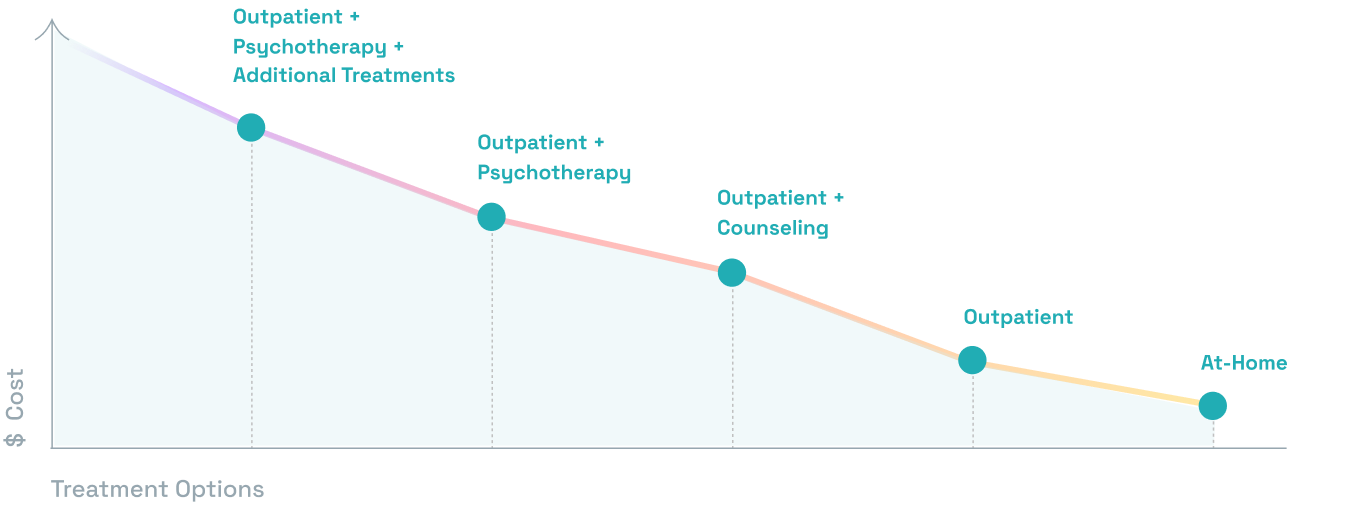
The Future of Ketamine
Despite gaining FDA approval as an anesthetic in 1970, research into ketamine’s potential uses for mental health, addiction, and pain is still relatively new. However, hundreds of active studies involving ketamine happen each year, contributing to a fast-growing body of research into ketamine’s wide range of possible applications.
Ketamine has a rapidly expanding array of potential uses. Researchers are actively delving into ketamine’s potential to treat conditions like anxiety, depression, PTSD, OCD, substance use disorder (SUD), chronic pain, and more. There are hundreds of active or completed studies and clinical trials involving ketamine, highlighting the promising future of its potential to revolutionize mental healthcare.
Ketamine has a rapidly expanding array of potential uses. Researchers are actively delving into ketamine’s potential to treat conditions like anxiety, depression, PTSD, OCD, substance use disorder (SUD), chronic pain, and more. There are hundreds of active or completed studies and clinical trials involving ketamine, highlighting the promising future of its potential to revolutionize mental healthcare.
FDA Approved (Esketamine)
Off-Label (Ketamine)
Sources Cited
- https://www.frontiersin.org/articles/10.3389/fnhum.2021.722323/full
- https://www.ncbi.nlm.nih.gov/pmc/articles/PMC6181464/
- https://www.ncbi.nlm.nih.gov/pmc/articles/PMC6328474/
- https://pubmed.ncbi.nlm.nih.gov/21039109/
- https://www.ncbi.nlm.nih.gov/pmc/articles/PMC5907920/
- https://www.ncbi.nlm.nih.gov/books/NBK470357/
- https://www.tandfonline.com/doi/abs/10.1080/02791072.2007.10399860
- https://www.frontiersin.org/articles/10.3389/fpsyt.2021.710338/full
- https://www.psychologytoday.com/us/therapy-types/integrative-therapy
- https://www.nature.com/articles/npp201719
- https://www.ncbi.nlm.nih.gov/pmc/articles/PMC8190578/
- https://www.ncbi.nlm.nih.gov/pmc/articles/PMC5729569/
- https://www.ncbi.nlm.nih.gov/pmc/articles/PMC4243034/
- https://www.ncbi.nlm.nih.gov/pmc/articles/PMC3799067/
- https://www.sciencedirect.com/science/article/abs/pii/S0166432822000729#!
- https://www.ncbi.nlm.nih.gov/pmc/articles/PMC6094990/
